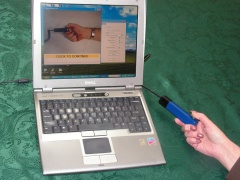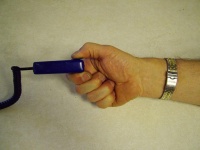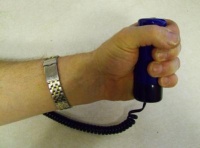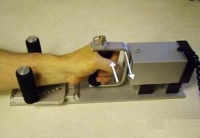Since the earliest days of the ERGOS® Work Simulator, we have been asked by many of our users if it was possible to purchase individual test components for testing use in the field or as an adjunct to therapy as a means for tracking the patient’s rehabilitation progress. Regrettably, this was nearly impossible and overly expensive in the original ERGOS® design since the operating system was DOS based and the electronic interface cumbersome. However, Simwork System’s partnership with Hardworks, Inc. of Tucson, Arizona, resulted in the design of the compact Sapphire™ Work Assessment System. The Sapphire™ system offered a new approach to human performance testing that includes simple USB computer interface and compatibility with the Microsoft® Windows™ operating system found on the vast majority of PCs throughout the world. These changes are at the forefront of the new Sapphire™ Quick Tester product line.
Quick Tester Solid-State Technology
In April of 2009, Simwork Systems proudly released the first component to be included in the Quick Tester line of human performance assessment tools. The Quick Tester pinch component makes use of the patent-pending solid state pinch gauge developed for the Sapphire™ Work Assessment System. The Quick tester pinch gauge is a robust heavy duty instrument that has proven to be a workhorse in the high volume treatment environment. It has many features that make it superior over older equipment designs that use oil pressure sensors. Without the oil pressure sensor, the Quick Tester pinch gauge has no possibility of leaking or losing its calibration because of sensor seal degradation common with outdated designs. The Quick Tester pinch gauge holds its calibration for long periods as long as the temperature environment remains relatively constant. Because the Quick Tester calibration is maintained by the computer it is connected to, it is a simple two minute routine to re-calibrate the instrument using the included interface software. You never lose its use because you have to send the Quick Tester to be calibrated by an outside source. Your calibration history is printed for record keeping evidence.
Computer-Interactive Design
 As with all Simwork Systems product designs, the Quick Tester makes use of computer administered test protocols that assures the activity was provided in an objective and informed-consent manner. Because each test is administered the same each time, there is no chance for error in test or testing error as is possible when the test administrator gives a test activity from memory. Likewise, the evaluee must provide interactive feedback and only she/he can make the test continue by acknowledging the instructions and physically giving permission by touching the screen of clicking the computer mouse before advancing the test. There is no possibility of misunderstanding as long as the Quick Tester procedures are followed thus protecting the evaluator from allegations that the evaluee did not understand what was requested of them or that they were forced to perform a test activity without the opportunity for questions or feedback. The Quick Tester product line will also be offered in multiple languages at the same comprehension level as provided in the North American English protocol to assure that the test is the same in any language provided. The evaluator has the ability to customize the test protocol using simple software controls included with the Quick Tester program. This feature provides flexibility required by various applications such as hand therapy, work hardening/conditioning, pre-employment testing and fitness for duty testing to name a few. Biofeedback graphic performance feedback can be turned on or off depending on application as needed by the evaluator. And performance reports are immediately available for inclusion into the patient’s record. The evaluator has the ability to edit their notes into the report record and can cut and paste performance recordings into common text editors such as Microsoft® Word™, Open Office.org Writer and WordPerfect™. The power of the Quick Tester software interface makes it ideal for on-location use in industry, itinerate services and the therapist’s treatment table.
As with all Simwork Systems product designs, the Quick Tester makes use of computer administered test protocols that assures the activity was provided in an objective and informed-consent manner. Because each test is administered the same each time, there is no chance for error in test or testing error as is possible when the test administrator gives a test activity from memory. Likewise, the evaluee must provide interactive feedback and only she/he can make the test continue by acknowledging the instructions and physically giving permission by touching the screen of clicking the computer mouse before advancing the test. There is no possibility of misunderstanding as long as the Quick Tester procedures are followed thus protecting the evaluator from allegations that the evaluee did not understand what was requested of them or that they were forced to perform a test activity without the opportunity for questions or feedback. The Quick Tester product line will also be offered in multiple languages at the same comprehension level as provided in the North American English protocol to assure that the test is the same in any language provided. The evaluator has the ability to customize the test protocol using simple software controls included with the Quick Tester program. This feature provides flexibility required by various applications such as hand therapy, work hardening/conditioning, pre-employment testing and fitness for duty testing to name a few. Biofeedback graphic performance feedback can be turned on or off depending on application as needed by the evaluator. And performance reports are immediately available for inclusion into the patient’s record. The evaluator has the ability to edit their notes into the report record and can cut and paste performance recordings into common text editors such as Microsoft® Word™, Open Office.org Writer and WordPerfect™. The power of the Quick Tester software interface makes it ideal for on-location use in industry, itinerate services and the therapist’s treatment table.
Sapphire™ Pinch

The introductory Quick Tester component, the Sapphire™ Pinch provides a simple easy to use isometric test device that provides the therapist and evaluator with quality measurement of the evaluee’s lateral or three-point pinch strength. The device simply plugs into the USB port on the evaluator’s computer and is immediately usable.
Sapphire™ Grip

The Sapphire™ Grip component uses the same solid-state design used with the Pinch component. This isometric test device uses the mean grip circumference for adults as a standardized method of documenting the evaluee’s functional circular grasp. Unlike old design bare metal grip devices, the Sapphire™ grip has a protective cushioned coating that is easily sterilized to prevent transfer of bio-organisms from one patient to another. The device simply plugs into the USB port on the evaluator’s computer and is immediately usable.
Sapphire™ Pro-Flex

The Sapphire™ Pro-Flex component advances the exclusive isometric test capability first developed on the original ERGOS® Work Simulator in the 1980’s. However, the Sapphire™ system has advanced this upper extremity testing technology to the next level with the Pro-Flex unique patent-pending design. The Sapphire™ Pro-Flex combines the test capabilities of two devices (the wrist flexion-extension and the forearm pronation-supination isometric test devices) originally introduced on the ERGOS®. The Sapphire™ Pro-Flex combines these two functional test devices into one tool. The Pro-Flex has had good success in measuring workers fit for duty in heavy manufacturing because of our ability to compare performance to specific U.S. DOT and Canadian NOC job standards. This is the only device in the world that measures these functional work components and compares performance to these published government job standards. The device simply plugs into the USB port on the evaluator’s computer and is immediately usable.